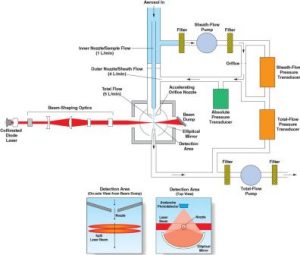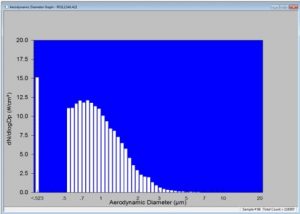Instrument Support Level 3
TSI 3321
ncas-aps-1, ncas-aps-2
aerosol-size-distribution
£30,000
38 cm × 30 cm × 18 cm. 2.1kg
50 cm x 40 cm x 30 cm. 20kg
£20
Calendar

Aerodynamic Particle Sizer
The 3321 Aerodynamic Particle Sizer (APS) spectrometer is a high-performance, general-purpose aerosol instrument.
The APS sizes particles in the range from 0.5 to 20 micrometers using a sophisticated time-of-flight technique that measures aerodynamic diameter in real-time. In addition, the monotonic response curve of the time-of-flight measurement ensures high-resolution sizing over the entire particle size range.
The APS detects particles from 0.37 to 20 micrometers using a light-scattering technique. While light-scattering intensity is not always a reliable indicator of particle size, it remains a parameter of interest. The APS keeps this second measurement separate and distinct from aerodynamic size.
Two identical units are available.
The APS accelerates the aerosol sample flow through an accelerating orifice. The aerodynamic size of a particle determines its rate of acceleration, with larger particles accelerating more slowly due to increased inertia. As particles exit the nozzle, they cross through two partially overlapping laser beams in the detection area. Light is scattered as each particle crosses through the overlapping beams. An elliptical mirror, placed at 90 degrees to the laser beam axis, collects the light and focuses it onto an avalanche photodetector (APD). The APD then converts the light pulses into electrical pulses. The configuration of the detection area improves particle detection and minimizes Mie-scattering oscillations in the light-scattering-intensity measurements. The use of two partially overlapping laser beams results in each particle generating a single two-crested signal. Peak-to-peak time-of-flight is measured with a 4-nanosecond resolution for aerodynamic sizing. The amplitude of the signal is logged for light-scattering intensity. The smallest particles may have only one detectable crest and are binned separately. In uncorrelated mode, these particles are displayed in the smallest size channel (less than 0.523 micrometers). Particles with more than two crests, indicative of coincidence, are also binned separately but are not used to build aerodynamic-size or light-scattering distributions.

The instrument is serviced annually by the manufacturer if the instrument has been used extensively. This includes checking the flow rate, optics alignment and replacing filters and tubing
It should be noted that there is no absolute calibration standard for particle number concentration. The sizing and counting efficiency is checked using PSL spheres and a reference counter.
A basic service check will be performed on the unit before it is shipped to the user.
Consumables
Tubing to connect the 3321 APS to a sampling system or environment will not be provided
Costs
- Instrument Insurance
- This system must be insured by the user for £30K and covers loss, theft or damage to the instrument: damage is that over and above general wear and tear.
- The system has been designed to be rugged and autonomous.
- Even so, the end-user must respect the fact that the system is a precision optical instrument that must be treated with great care.
- The user is responsible for the instrument from the time it leaves the AMoF to the time it is returned and signed off as in an acceptable operating condition by the IS: this will be done as soon as is possible on its return.
- Public Liability Insurance
- AMOF is not liable for any damage or injury arising from the deployment or operation of this instrument when unattended by the Facility Scientist.
- Shipping Expenses
- The user is liable for all costs arising from the shipping of the instrument both to and from deployment.
- IS T&S
The user is responsible for coving the travel and subsistence expenses of the Facility Scientist while attending the instrument.
Shipping
Please contact the IS for details nearer the time of shipping. If exact weights and dimensions are required, these can be arranged with the IS.
The instrument needs to be housed in a dry environment that does not exceed the environmental conditions as detailed in the specifications. The instrument should be situated on a level surface.
Eye safety
- This 3321 APS is a class 1 laser-based instrument and is eye-safe for all conditions of use, providing the covers are not removed.
Electric safety
- Under no circumstances should any attempt be made to open up the main body of the instrument. This will expose the user to high voltages. Only appropriately qualified persons should attempt to fault find these units.
Attended operation
- There is no requirement for the system to be attended during operation from a safety standpoint.
COSHH
- There are no chemicals used in the operation of this product.
Particle Size Range
- 0.5 to 20 μm aerodynamic size, 0.3 to 20 μm optical size (PSL equivalent)
Maximum Particle Concentration
- 1000 pt/cm3 at 0.5 μm with less than 2% coincidence. 1,000 pt/cm3 at 10.0 μm with less than 6% coincidence.
Display Resolution
- 32 channels per decade of particle size (logarithmic). This results in 52 channels total. 1,024 bins of raw time-of-flight data (4 ns per bin).
Resolution
- 0.02 μm at 1.0 μm diameter. 0.03 μm at 10 μm diameter.
Sampling Time
- Programmable from 1 second to 18 hours.
Flow Rates
- Aerosol sample: 1.0 ±0.2 lpm; Sheath Air: 4.0 ±0.1 lpm; Total flow: 5.0±0.1 lpm (feedback controlled).
Flow Control
- Internal brushless DC pumps.
Atmospheric Pressure Correction
- Automatically corrected between 600 mbar and 1034 mbar.
Concentration Accuracy
- ±10% of reading plus variation from counting statistics.
Operating Temperature
- 10 to 40°C (50 to 104°F).
Operating Humidity
- 10 to 90% RH non-condensing.
Laser Source
- 30 mW, 680 nm laser diode.
Power
- 85 to 264 VAC, 50–60 Hz, 100 W, single phase or 24 VDC.
Communications
- RS232 (9-pin) port, 7 bits, even parity, 9600:19200:38400 baud.
Outputs
- Digital I/O: 15-pin port (3 input, 3 output).
Analog and digital pulse: BNC. Configurable analog: BNC.
Dimensions (LWH)
- 380 mm × 300 mm × 180 mm
Weight
- 10 kg
This instrument measures the size-resolved number concentration per cubic centimetre of particles in the size range of 0.5 to 20 microns (aerodynamic), with 32 bins per decade and a total of 52 bins. In addition, it also measures the optical scatter intensity from particles in the size range 0.3 to 20 um (PSL equivalent diameter).
Field Data
- The instrument produces a range of out files and all are text format.
- The user can download (but not delete) this data from the instrument but it should be noted that this data will not have been quality controlled.

The basic data output is to plot a number size distribution, as shown above.
Archive Data
- Data is provided in NetCDF files following the AMOF data standard
- Files contain no more than 24hr of data.
- Instrument name is
- ncas-aps-1,
- ncas-aps-2
- The data product(s) associated with this instrument:
- Example data file
